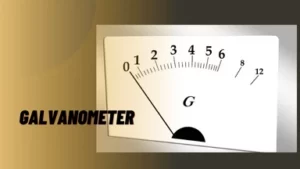Galvanometer is such a device with the help of which we can measure small current in an electric circuit. If you want to measure small current in an electric circuit, you will need a galvanometer.
And by using this you can find the presence of current or voltage in a closed circuit. And this cable can be done by galvanometer only. You will be able to use it mainly in potentiometers and bridges. It is very sensitive and stable zero instrument.

But is this question coming in your mind too? Who invented the galvanometer? Then you will get its answer too. So let’s know, the galvanometer was invented by Andre-Marie Ampere (France) in the year 1834.
See also this : Agni 5 missile – Agni 5 range
Why is galvanometer used in a circuit?
Galvanometers are used in circuits because through galvanometers the presence of current in the circuit can be detected as well as the direction of that current can also be detected.
So this is the reason for using galvanometer. Then let us also know about its two uses.
What are two uses for a galvanometer?
Two uses of galvanometer – 1st one , Using it, you can also make an ammeter or a voltmeter. 2nd – And using this can convert galvanometer to make ammeter or voltmeter.
By the way, apart from these two, there are many other types of uses, so let’s know a little about it too.
- Using this we can get information about current flow in any circuit.
- By using this we can determine the null point of a circuit. Null point is a condition in which no current will flow through a circuit.
- If you want to know the voltage of two points in a circuit, then you have to use a galvanometer for that.
What is the principle of galvanometer?
So friends, now let’s know, on what principle this device works.
To know the principle of this device, first of all a coil has to be placed in a uniform magnetic field. After that electric current has to flow in it.
When electricity flows, a force will act on the coil. And the value of this force will depend on the magnitude of electric current flowing in the coil. This means that the more electric current flows, the more the value of torque will also increase.
Types of galvanometer.
There are types of galvanometer, such as –
- Tangent galvanometer
- Astatic galvanometer
- Mirror galvanometer
- Ballistic galvanometer
What are the different types of vibration galvanometers?
The different types of vibration galvanometers are –
- The moving coil type vibration galvanometer.
- The moving magnet type vibration galvanometer.
That is, there are two types of galvanometers available.
Construction of vibration Galvanometer –
The construction of this device is as follows – it has permanent magnets and a bridge piece for vibration. And it has a mirror which will reflect the beam of light on the scale.
So here is a little information about its construction. So let’s now know its unit as well. Its unit is also very attractive because in many examinations questions related to the unit are asked. And further questions are likely to be asked. That’s why you have to understand and remember its unit very well. So let’s know.
What is galvanometer’s unit?
Its unit is SI unit. Which is the current sensitivity unit. That’s why it is call the current sensitivity unit of the galvanometer’s. And its current sensitivity unit is – division/ampere (or) radian/ampere.
And its symbol is represents by the letter “G”.
What is the formula of galvanometer constant?
The formula of galvanometer constant is I = (C / nBA) × θ , and here the torsional constant of the spring is “C” . Which is restoring torque per unit twist. There is a pointer in the spring, which will indicate the deflection of θ in the scale.
What is the unit of displacement constant in galvanometer?
The displacement constant of the galvanometer’s is G, and its value is equal NBA = Nbld. But , For small deflection angles, deflection is expressed as the product of radius and rotation , and for the reflected beam, this is expressed as 1000 Χ 2θF = 2000 Gi / K in millimeters.
What are the components of a galvanometer?
Galvanometer’s main components are the moving coil, the suspension, the torsional head and the permanent magnet. So let’s know about them in detail.
Moving coil – The galvanometer’s having the moving coil is a current carrying part. It will be seen in rectangular or circular. And in this you will get to see many coils of thin fine copper wire, The coils in it move freely. There is a permanent magnet in the middle of its vertical axis of symmetry. In this it provides iron core of low reluctance flux path. That’s why it provides strong magnetic field coil.
Suspension – Coil is suspend in this. And a flat ribbon is use to suspend it. which is carry the current to the coil. And the second current carrying coil is the lower suspension , Whose torque effect is very negligible.
The upper suspension coil is made of gold or copper wire, which is in the form of a ribbon. The mechanical strength of the wire is not as strong as it should be. Hence the galvanometer needs to be handle with care.
Mirror-There is a small mirror in suspension present in the galvanometers, which emits rays of light. The beam of light is placed on the scale. So that the deflection can be measure.
Torsion Head – The torsion head is used to control the position of the coil, and adjust to zero setting.
So this is some important information about Galvanometer’s. All of you have definitely got to know and understand something better from this article of ours. This is our hope. please share this article with your friends.
